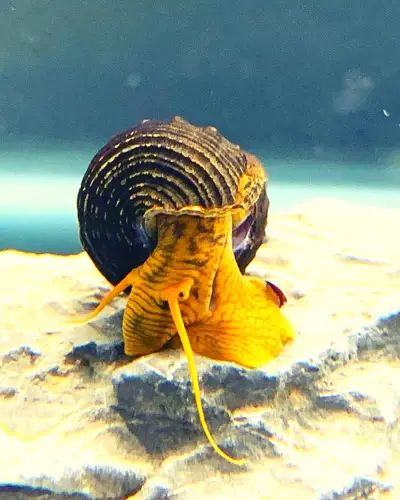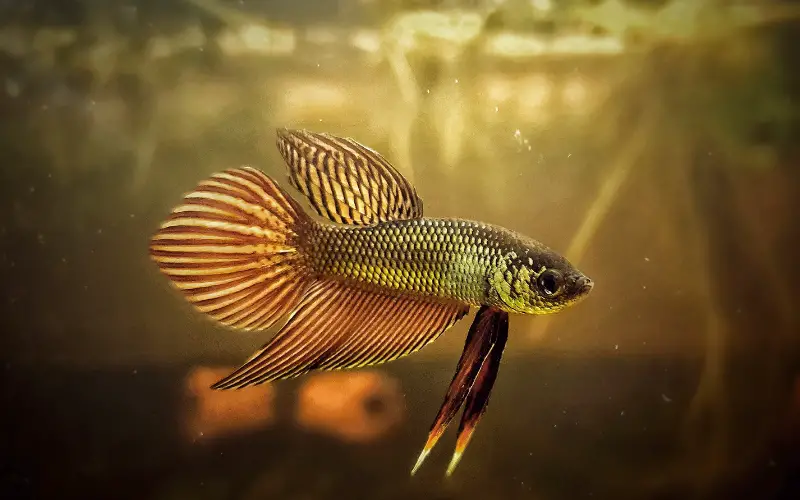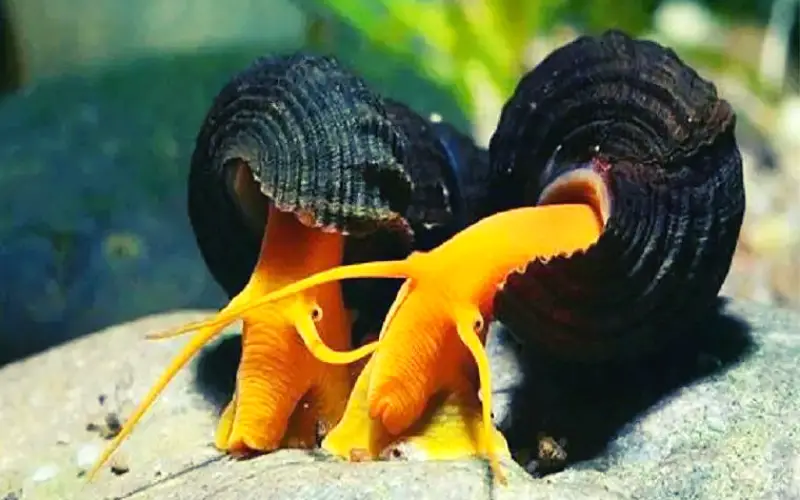Can bettas and rabbit snails live together peacefully? Keeping Rabbit Snail with Betta fish can be a rewarding experience for hobbyists looking to diversify their aquariums.
Rabbit Snails are known for their unique appearance and gentle demeanor, making them a great addition to a Betta Fish tank.
However, it is essential to ensure both species are happy and healthy in their shared environment.

This article will discuss five proven tips for keeping Rabbit Snails with Bettas happy. From water parameters to feeding habits, we will explore the key factors contributing to this tank combination’s success.
Following these tips can create a harmonious and thriving ecosystem for your Rabbit Snails and Betta Fish. So, if you are considering adding these two species to your aquarium, read on to discover how to ensure they coexist peacefully and happily.
Table of Contents
ToggleCan Rabbit Snails Live with Bettas?
Rabbit snails can live with bettas in aquariums. However, it’s crucial to consider a few factors. Make sure the tank has sufficient space and hiding spots for both species.

Provide a balanced diet to prevent the Betta from nibbling on the snail’s antennae. Also, proper water parameters that are suitable for both creatures must be maintained. Regular monitoring and observation are essential to ensure compatibility.
Overview of Betta Fish and Rabbit Snail Compatibility
Betta fish and Rabbit Snails can generally coexist peacefully in a freshwater tank. Betta fish, also known as Siamese fighting fish, are known for their vibrant colors and active behavior.
They belong to the genus Betta and are sensitive to water temperature and quality. Rabbit Snails, on the other hand, are slow-moving snails from the Sulawesi region. They are known for their large, conical shells and curious, peaceful nature.
Rabbit snails belong to the genus Tylomelania and are excellent clean-up crew members, feeding on algae and leftover food in the tank. They need a stable environment with plants, sand, and hiding spots to thrive.
Monitoring the tank’s water parameters and ensuring a proper cycle is established before introducing these creatures is essential. It is advised to seek advice from the Betta fish forum or articles and discussions to ensure compatibility and provide the best care for both species.
What Do Betta Fish and Rabbit snails eat?
Betta fish and rabbit snails have different dietary requirements. Here’s what they typically eat: Bettas are carnivorous and primarily eat meat-based foods. Their natural diet consists of small insects, larvae, and zooplankton.
In captivity, they are fed a diet of high-quality betta pellets or flakes formulated explicitly for their nutritional needs. These foods often contain a mix of protein sources such as fish or shrimp meal. Choosing a balanced diet that provides essential nutrients for their overall health is best.
In addition to pellets or flakes, you can supplement your Betta’s diet with live or frozen foods like bloodworms, daphnia, brine shrimp, or tiny insect larvae. These foods can provide variety and mimic their natural diet. However, it’s important not to overfeed them as they tend to overeat, which can lead to health problems.

Rabbit snails are herbivorous and mainly feed on plant matter. They graze on algae, residue, and decaying plant material. They will typically find enough food in a well-established aquarium to sustain themselves.
However, you can supplement their diet with blanched vegetables like zucchini, spinach, or cucumber slices. These vegetables should be boiled or steamed briefly to soften them before offering them to the snails. Removing uneaten vegetables from the tank after a few hours is essential to prevent water quality issues.
Additionally, rabbit snails may feed on biofilm and algae that naturally grow on surfaces in the aquarium. Providing them with various surfaces and textures, such as rocks or driftwood, can help ensure they have enough food.
Remember to observe your fish and snails while feeding to ensure they consume the food and adjust their diet accordingly.
Critical Considerations Before Housing Rabbit Snail with Betta Fish
Here are some key considerations before housing a rabbit snail with a betta fish:
Habitat:
- Size: Rabbit snails can grow quite large, up to 5 inches in shell diameter. Betta fish need at least 5 gallons of water, but 10 gallons is much better to provide enough space for both creatures to thrive.
- Filtration: Rabbit snails produce a lot of waste, so a strong filter is essential to maintain good water quality for both the snail and the fish.
- Plants: Live plants are recommended for snails and betta fish. Rabbit snails will graze on algae and biofilm but may also munch on live plants. Choose plants known to be rabbit snail resistant, such as Anubias, Java Ferns, or Hornwort.
Temperament:
- Predation: While betta fish are not typically aggressive towards snails, there is a chance that a betta fish could view a rabbit snail as prey, especially if the snail is small. If you are concerned about this, it is best to err on the side of caution and choose a different tank mate for your betta fish.
- Competition: Rabbit snails are known to be peaceful scavengers. However, they can compete with betta fish for food. Make sure to provide enough food for both the snail and the fish.
Water Parameters:
- Rabbit snails: Prefer slightly hard water with a pH between 7.0 and 8.0.
- Betta fish: Thrive in various water conditions but prefer slightly acidic water with a pH between 6.5 and 7.5. You can monitor your water parameters with a freshwater test kit
5 Essential Tips for Keeping Rabbit Snail and Betta Fish Together
While keeping rabbit snails and betta fish together is possible under certain conditions, it’s not ideal for either animal. Here are some things to consider:
- Rabbit snails can grow quite large: Rabbit snails can grow to be 3 inches or more in length, which can be too large for some betta fish tanks.
- Bettas can be aggressive: While some bettas may be fine with tankmates, others can be aggressive, especially towards slow-moving creatures like rabbit snails.
- Rabbit snails can outcompete bettas for food: Rabbit snails are herbivores and will eat algae and other plant matter in the tank. This can leave less food available for the betta fish, an omnivore.
If you’re still set on keeping these two together, here are some tips:
- Choose a large tank: A 10-gallon tank is the minimum recommended size for a betta fish, and even more significant is better if you want to add a rabbit snail.
- Provide plenty of hiding places: The more hiding places in the tank, the less likely the Betta will harass the snail.
- Feed your Betta a healthy diet: A well-fed betta fish is less likely to be aggressive towards tankmates.
- Monitor the tank closely: Monitor the Betta and the snail to ensure they get along. If you see any signs of aggression, you must separate them.
- Have a backup plan: Be prepared to separate the Betta and the snail if things don’t work out. Have another tank ready in case you need to isolate either animal.
What Tank Setup Works Best for Rabbit Snail and Betta Fish: (Rabbit Snail with Betta Tank Setup)
When setting up a tank for Rabbit Snails and Betta Fish, it is crucial to consider their needs and behaviors. Rabbit Snails prefer a heavily planted tank with soft substrate to bury themselves in, while Betta fish thrive in calm waters with plenty of hiding spots.
Including live plants such as moss and driftwood can provide a naturalistic environment for both species. Additionally, adding Nerite or Mystery Snails can help keep the tank clean, as they are excellent algae eaters.
Some owners also like to include shrimp or plecos to help with tank maintenance. It is essential to reproduce the fishes’ natural habitat, such as a small island for the Betta fish to rest on or rocks for the Rabbit Snails to climb.
Remember that Betta Fish are known to be territorial, so it’s best to avoid housing them with aggressive or fin-nipping fish such as cichlids. Regarding tank size, a minimum of 10 gallons is recommended for one Betta fish, while Rabbit Snails will appreciate a larger tank to roam in.
When introducing these species, it’s essential to check their compatibility and closely monitor their interactions. Overall, a well-planned tank setup can create a harmonious environment for both Rabbit Snails and Betta fish.
Choosing the Right Tank Size for Your Fish and Snail: (Rabbit snail with betta tank size)
Choosing the Right Tank Size for Your betta Fish and Snail can be crucial when setting up your aquarium. It’s essential to relate the tank’s size to your aquatic pets’ needs. I’ve seen Golden plecos outgrow their tanks because their owners didn’t realize how big they could get.
Bettas are known to be territorial, so a larger tank with plenty of hiding spots is recommended. When deciding on tank size, consider the number and size of fish or snails you plan to keep. A funny picture or video can help you visualize the space they need.
A lake-sized tank isn’t necessary for fish like tetras and rasboras, but they still need room to swim. Please check the dimensions and gravel sponge to create a suitable environment.
Some pet stores may advise on the right tank size for different species. Keep in mind that wild fish are used to having more space to roam, so a larger tank can help them feel more at home. Okay, so how big of a tank do you need?
Essential Tank Equipment for Housing Betta Fish and Rabbit Snail: Bettas and Rabbit Snail Tank Setup
When it comes to housing Betta fish and Rabbit Snails, you will need a few essential tank equipment items to ensure they thrive in their environment. If you need advice on what to get, a heater is a must for Betta fish as they require warm water to stay healthy.
A good filter is also essential to keep the water clean and oxygenated. For Rabbit Snails, a substrate miming their natural lake habitat is ideal. A pleco cave or structure is also recommended to give them a place to hide and feel secure.
Here is the essential tank equipment for housing betta fish and rabbit snails:
Tank
- Size: While a minimum of 5 gallons is recommended for bettas, a 10-gallon tank is ideal to provide enough space for both the Betta and the snail. Rabbit snails can grow up to 2 inches long, so a larger tank is better.
- Material: Glass is preferred for tanks because it is more transparent and scratch-resistant than acrylic. However, acrylic tanks are lighter and more impact-resistant, making them a good option for homes with children or pets.
Lid
- A tight-fitting lid is essential to prevent your betta fish from jumping out. Bettas are known jumpers, and a lid will help to keep them safe.
Filter
- A filter is necessary to remove waste products from the water and keep it clean. A sponge filter is a good option for a betta tank because it is low-flow and will not create a strong current that can stress your betta fish.
Heater
- Betta fish are tropical fish and require warm water to thrive. A heater will help to keep the water temperature between 78-82 degrees Fahrenheit.
Thermometer
- A thermometer is necessary to monitor the water temperature and ensure it stays within the proper range for your betta fish.
Substrate
- Substrate is the material that goes on the bottom of the tank. Gravel is a popular choice for substrate, but it can be challenging to clean. Sand is a softer option that is easier on the fins of bettas. However, it can also be challenging to clean. Specialized betta substrates are also available that are designed to be easy to clean and help maintain water quality.
Lighting
- Betta fish do not require a lot of light, but they will benefit from some aquarium lighting. LED lights are a good option for betta tanks because they are energy-efficient and do not produce much heat.
Decorations
- Decorations can provide hiding places for your betta fish and help to make the tank look more attractive. However, it is essential to choose decorations that are smooth and free of sharp edges that could injure your betta fish. Live plants are a good option for betta tanks because they can help to improve water quality and provide hiding places for your fish.
Rabbit snails are relatively low-maintenance creatures but appreciate hiding places in the tank. Driftwood or live plants can provide good hiding spots for rabbit snails.
What Are Compatible Tankmates for Betta Fish and Rabbit Snail?
While rabbit snails are generally peaceful and compatible with betta fish, it’s important to remember that every fish has its personality.
Some bettas may be more aggressive than others and might harass or even attack tank mates.
Here are some compatible tankmates for betta fish and rabbit snails, keeping in mind the need for a peaceful betta and a giant enough tank:
Good options:
- Small, peaceful schooling fish: Neon tetras, cardinal tetras, rummy-nose tetras, harlequin Rasboras, ember tetras. These fast-moving fish stay away from the bottom of the tank where the rabbit snail resides.
- Bottom feeders: Corydoras catfish (such as pygmy Corydoras or peppered Corydoras) are peaceful and help clean up leftover food.
- Dwarf shrimp: Cherry shrimp or Amano shrimp can be good companions, but ensure your Betta isn’t prone to hunting them.
- Other snails: Mystery, Malaysian trumpet, and nerite snails are all peaceful and compatible with rabbit snails.
Avoid:
- Fish with long, flowing fins: Bettas may mistake them for rivals and attack.
- Aggressive fish: Cichlids, barbs, and some gourami species can be aggressive and should be avoided.
- Large fish: Any fish large enough to eat the rabbit snail is a threat.
General considerations:
- Tank size: The tank should be large enough to accommodate all inhabitants comfortably. A minimum of 10 gallons is recommended for a betta and a rabbit snail, with additional space needed for other tank mates.
- Hiding places: Provide plenty of hiding places for the rabbit snail and other tank mates to escape the Betta’s attention if needed.
- Monitor behavior: Always monitor the behavior of your Betta and other tank mates for any signs of aggression. Be prepared to separate them if necessary.
Remember, even with careful selection, there is always a tiny risk of aggression. Observing your fish and preparing to make adjustments, if necessary, is crucial.
Related Questions about Keeping Rabbit Snail with Betta Fish (FAQs)
Can I put snails with my Betta?
Yes, but with caution! Peaceful snails like Mystery or Nerite can be tankmates, but avoid small snails your Betta might see as food. Continuously monitor for signs of aggression.
Are rabbit snails invasive?
No, rabbit snails are not invasive. They are popular aquarium snails known for algae control and peaceful behavior. Their slow reproduction prevents them from overpopulating.
What is the best bottom feeder for a betta fish tank?
What bottom feeders are good for bettas? Corydoras catfish are peaceful and small, so they are ideal for tanks with bettas. They scavenge for leftover food, helping keep the tank clean.
What fish can live with rabbit snails?
Peaceful community fish like tetras, Rasboras, or Corydoras catfish are good tankmates for elephant snails. Avoid aggressive fish or those known to eat snails.
What kind of snail is best with a betta fish?
Mystery snails or trapdoor snails are peaceful options for betta tanks. Avoid small snails or aggressive apple snails.
Can snails be toxic to betta fish?
No, snails themselves aren’t toxic to betta fish. However, dead snails can pollute the water, so prompt removal is essential.
What is best for the bottom of a betta tank?
There are three good options for a betta tank bottom: gravel, sand, or bare bottom. Gravel is most accessible to clean, sand is soft on betta fins, and the bare bottom makes it easy to see dropped food.
What is the best tank set up for a betta fish?
The best betta tank is at least 5 gallons with a heater, filter, and lid. Skip the tiny bowls! Bettas love plants for hiding and exploring.
Conclusion
In conclusion, keeping a rabbit snail with betta fish can be a rewarding and harmonious combination in your aquarium. While bettas are known for their territorial behavior, elephant snails’ peaceful and non-intrusive nature makes them ideal tank mates. They help maintain a clean and healthy environment by consuming excess algae and detritus, while their unique appearance adds a touch of elegance to your aquatic landscape. You can create a thriving ecosystem where both species coexist peacefully by providing ample space, hiding spots, and ensuring proper water parameters. So, go ahead and introduce a rabbit snail to your betta tank and witness the captivating beauty of this symbiotic rabbit snail with betta fish relationship firsthand.
Top Posts – More posts you may like
- Rabbit Snail Lifespan: 5 Secrets to Double Their Years!
- How Do Rabbit Snails Reproduce: (Mind-Blowing Facts)
- Rabbit Snail Not Moving in Aquarium: (Troubleshooting Tips)
- Rabbit Snail Tank Size 101: Setting Up the Perfect Aquarium
- How Big Do Rabbit Snails Get in a Tank: (Quick Facts!)
- What Do Rabbit Snails Eat: (5 Foods They Can’t Resist!)
- Baby Rabbit Snail: 5 Ways to Avoid Disaster! (Expert Tips)
- Mini Rabbit Snails 101: Secrets for Raising Like a Pro!
- Rabbit Snail Temp 101: a Comprehensive Care Guide
- Orange Giant Sulawesi Rabbit Snails Care Guide (Must Read)




